
Late summer through autumn is the main season for mushrooms. A wide variety of species can then be found in the woods and fields. In addition to brown, red or greenish mushrooms, there are also mushrooms with white hats.
In a nutshell
- white mushrooms easily confused
- with increasing age often discoloration of the white color of the hat
- white fungi found in deciduous and coniferous forests, on meadows and fields
- not all white mushrooms are edible
Table of contents
- Identify mushrooms correctly
- White mushrooms from F to G
- White mushrooms from K to R
- White mushrooms from S to W
- frequently asked Questions
Identify mushrooms correctly
Care should be taken when identifying white mushrooms, not all are edible. Some good edible mushrooms from them have some inedible or toxic double. Depending on the location, the weather and the age, the white skin of the hat can show discoloration. Below we present the most common and well-known white mushrooms that grow in this country.
A notice: Collect only those mushrooms that you are sure about as edible recognize!
White mushrooms from F to G
Field funnel (Clitocybe quisquiliarum)
It is often found standing in witch rings in grassy areas, but is always found near trees. Due to its high muscarin content, the field funnel is classified as poisonous.
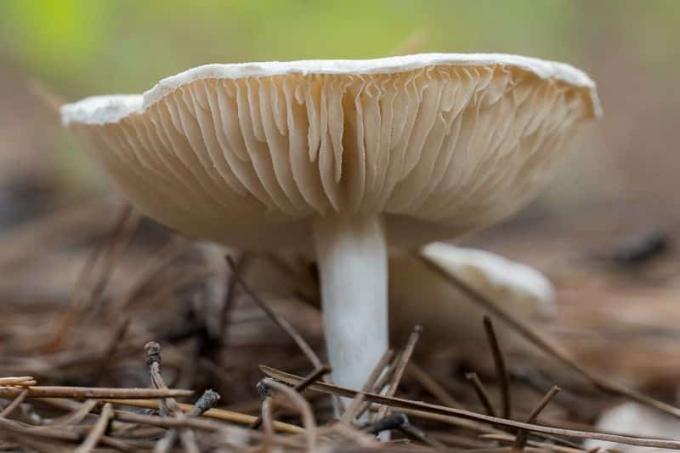
- Hat color: white, turning ocher with age
- Hat shape: 2 to 4 cm in diameter, initially convex, then spread out, finally indented like a funnel, thin, wavy edge
- Stem: 2 to 5 cm, white, tough, cylindrical, tapering downwards
- Lamellae: very dense, decurrent on the stem, white, light yellow when old
- Flesh: fine-fibrous, whitish
- Taste: mild
- Odour: mealy
- Season: July to November
- Occurrence: Meadows, pastures, parks, grassy forest edges
- Risk of confusion: edible flour rasp (Clitopilus prunulus)
A notice: If consumed, severe poisoning can occur after one to two hours. The first symptoms are excessive salivation and tearing, sweating, vomiting, diarrhea followed by a drop in blood pressure and breathing difficulties.
Frayed Amanita (Amanita strobiliformis)
This mushroom is a good edible mushroom. However, you should remove the hat skin before preparing it, as it has a very earthy taste.

- Hat color: snow-white with grey-brown warts
- Hat shape: 8 to 20 cm in diameter, initially spherical, then convex, later flat
- Stem: 10 to 25 cm, white, bulbous at the base
- Lamellae: white, dense, not fused with stem
- Flesh: white, compact, firm
- Taste: pleasantly mild
- Odour: nutty
- Season: June to September
- Occurrence: Deciduous forest, preferably under beeches and oaks
- Risk of confusion: cone-shaped death cap (Amanita virosa)
Spring death cap (Amanita verna)
Just like the death cap and death cap mushroom, this species contains Amanita toxins. The mushrooms belong to the deadly poisonous death cap mushrooms.
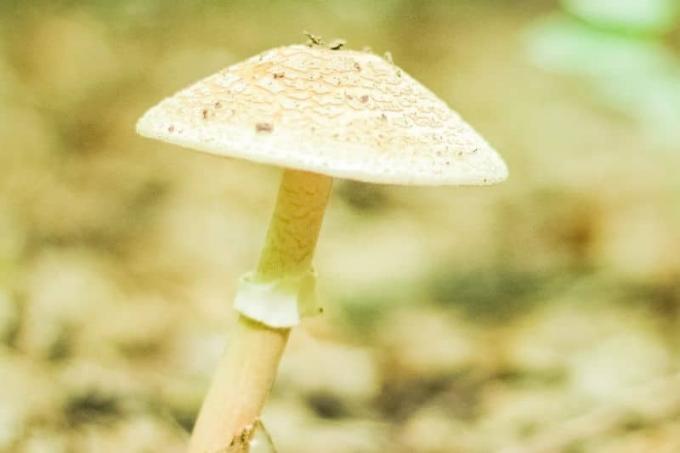
- Hat color: white with cream center
- Hat shape: 5 to 15 cm in diameter, initially hemispherical, later almost flat, edge often wavy
- Stem: 5 to 12 cm, white, slightly thickened at the base, weakly developed cuff
- Lamellae: white, very close together, numerous intermediate lamellae
- Flesh: white, tender
- Taste: unpleasant
- Odour: very mild
- Season: June to September
- Occurrence: Deciduous forests, parks, preferably under oaks
- Likelihood of confusion: meadow mushroom (Agaricus campestris), white anischampignon (Agaricus arvensis)
Gold Tooth Snail (Hygrophorus chrysodon)
The mushroom is edible, but it is often attacked by maggots. Nevertheless, it is well suited as a "side mushroom" for mixed mushroom dishes.
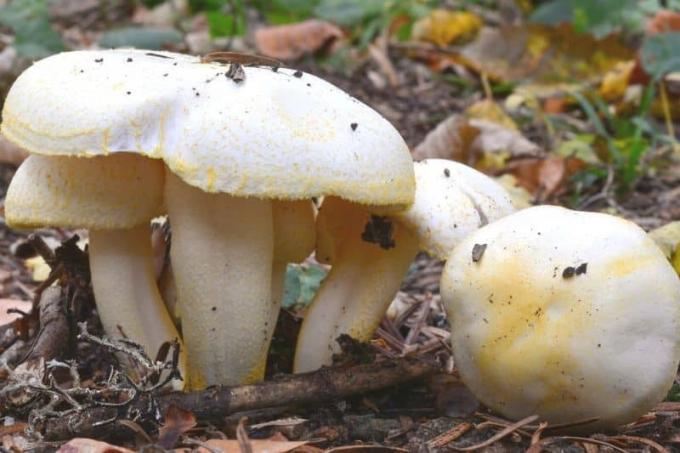
- Hat color: white, turning yellow with rubbing and with age
- Cap shape: 4 to 8 cm in diameter, covered with flakes, initially convex, later bluntly humped, thin cap brim, overhanging tooth-shaped flakes
- Stem: 4 to 8 cm, white, cylindrical, tapering downwards, with yellow flakes at the tip
- Lamellae: thick, distant, attached or decurrent
- Flesh: tender, juicy, white
- Taste: none
- Odor: none
- Season: August to November
- Occurrence: Deciduous and coniferous forests, preferably under spruce, oak and beech, occurring in groups
- Risk of confusion: discoloring snail (Hygrophorus discoxanthus), ivory snail (Hygrophorus eburneus), both inedible
White mushrooms from K to R
Carbolic Mushroom (Agaricus xanthodermus)
Also known as Poison Egerling. After consumption, violent vomiting and diarrhea occur.
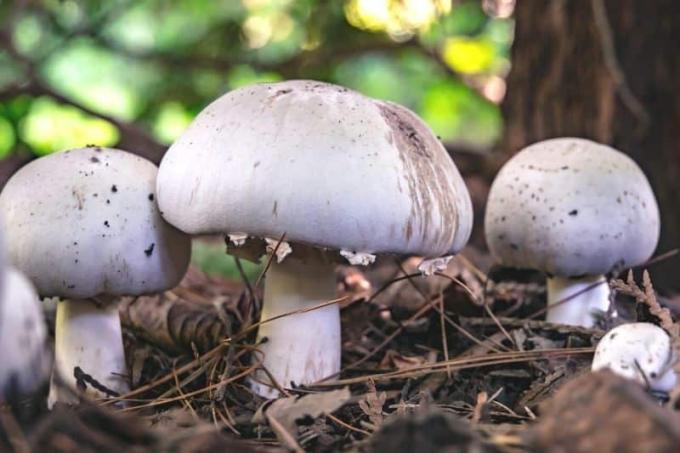
- Hat color: white, yellow discoloration from rubbing
- Hat shape: 5 to 12 cm in diameter, initially spherical, then convex, finally spreading
- Stem: 6 to 12 cm, white, cylindrical, bulbous at the base, white membranous ring peelable upwards
- Lamellae: dense, not attached to the stem, initially whitish, then pink, later chocolate brown to black
- Flesh: white in the upper part of the stalk, tinged sulfur yellow towards the bottom
- Taste: unpleasant
- Odour: smelling of carbolic (disinfectant).
- Season: July to October
- Occurrence: Deciduous and coniferous forests, gardens, meadows, parks, growing in larger groups
- Risk of confusion: thin-fleshed aniseed germ (Agaricus silvicola), meadow mushroom (Agaricus campestris)
long handledPeppermilk (Lactifluus piperatus)
Due to its sharpness, the mushroom is not very edible. However, dried and ground it can be used instead of pepper.
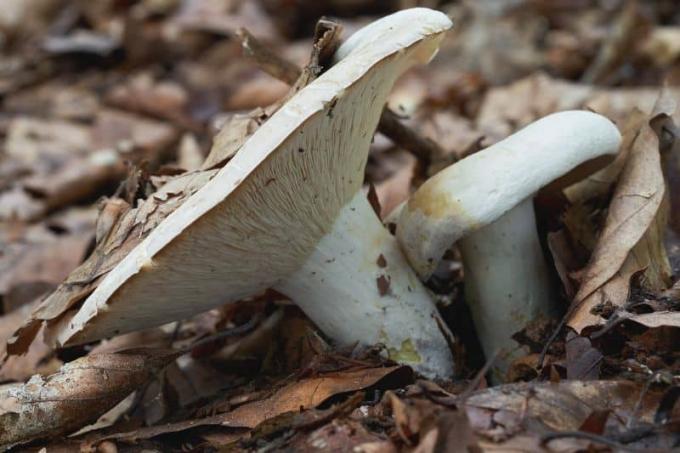
- Hat color: white to off-white
- Hat shape: 6 to 18 cm in diameter, initially convex, later funnel-shaped, wavy surface, lobed edge
- Stem: 4 to 10 cm, white, stocky, full, tapering at the base
- Lamellae: very broad, densely descending on the stem, partly forked, initially white, later cream-colored
- Flesh: hard, firm, white
- Taste: burning hot
- Odor: none
- Season: July to October
- Occurrence: in shady, moist places in deciduous and coniferous forests, standing in circular groups or rows
- Likelihood of confusion: woolly milkcap (Lactifluus vellereus), green end pepper milkcap (Lactifluus glaucescens)
Meal rasp (Clitopilus prunulus)
The flour rasling is a good and tasty edible mushroom. It owes its name to its strong flour smell.

- Hat color: white, sometimes slightly light grey
- Hat shape: 3 to 7 cm in diameter, initially hemispherical, later broadly flared, slightly deepened
- Stem: 4 to 6 cm, white, fibrous, serrated, eccentrically fused to the cap, dusty on top, white tomentose below
- Lamellae: thin, very dense, decurrent on the stem, initially white, later pink to rust-red
- Flesh: tender, brittle
- Flavor: floury
- Odor: like flour
- Season: June to November
- Occurrence: Deciduous and coniferous forests, preferably near spruces, forest meadows
- Likelihood of confusion: field trumpet (Clitocybe dealbata), rinnig frosted trumpet (Clitocybe rivulosa), both very poisonous
Giant Puffball (Calvatia gigantea)
The giant puffball is a very tasty edible mushroom, but only as long as the meat is still white. It can then also be used raw in salads.
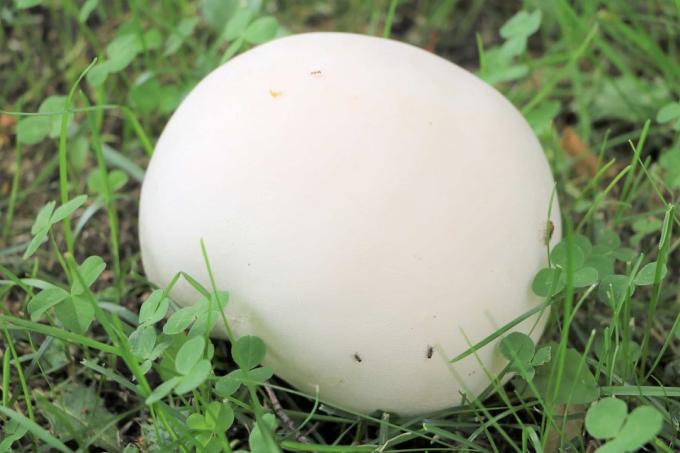
- Fruit body colour: white, yellow to olive-brown when old
- Fruit body: 7 to 100 cm, spherical, smooth, leathery outer layer, thick mycelium strands at the base, connected to the substrate
- Fruit mass: initially white and firm, with increasing age brown, greasy, later powdery consistency
- Taste: hardly pronounced
- Odor: pleasant
- Season: July to October
- Occurrence: Meadows, pastures, gardens, parks
White mushrooms from S to W
Ink Cap (Coprinus comatus)
Unfortunately, the very good edible mushroom can only be eaten when it is young. However, if the lamellae on the asparagus mushroom turn pink, it should no longer be collected.
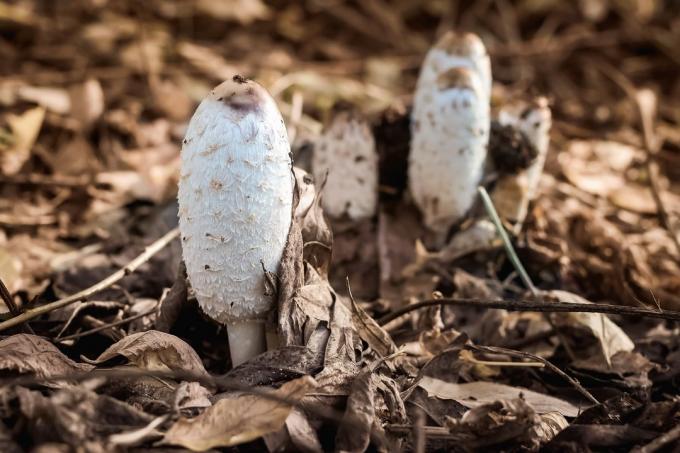
- Hat color: white, ocher on crown, gray with black edge when old
- Hat shape: 3 to 8 cm in diameter, initially cylindrical, later bell-shaped, finally spreading, fringed brim
- Stem: 5 to 18 cm, white, hollow, cylindrical, fibrous and scaly, base tuberous and thickened
- Lamellae: broad, dense, not attached to the stem, initially white, later pink, then black
- Flesh: tender, white
- Taste: mild
- Odor: pleasant
- Season: May to November
- Occurrence: roadsides, fertilized meadows, fields, gardens, compost heaps
- Likelihood of confusion: Gray Tintling (Coprinus atramentarius)
Tip: Mushrooms should be carefully twisted out of the ground when collected or cut off at the base with a sharp one. You should then transport your prey in an open basket so that it gets plenty of air.
White aniseed mushroom (Agaricus arvensis)
With age, the mushroom can reach a considerable size. It's one of the tastiest mushroom species.
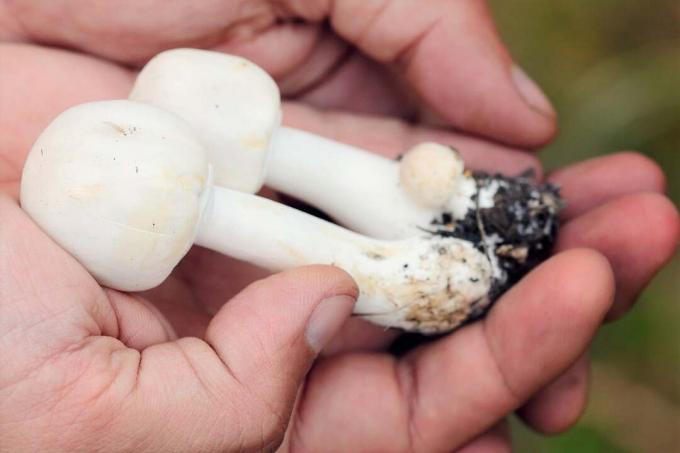
- Hat color: white, turning lemon yellow or reddish to the touch
- Hat shape: 5 to 20 cm in diameter, initially hemispherical, later convex to flat, often with a bumpy centre, torn edge
- Stem: 8 to 15 cm, white, cylindric, slightly bulbous base, pendent bilayered ring
- Lamellae: dense, not attached to the stem, initially white, later pink to chocolate brown
- Flesh: firm, tender, white, turning light yellow to slightly reddish when pressed
- Taste: nutty
- Odour: aniseed
- Season: May to October
- Occurrence: grassy areas, parks, sunny deciduous and coniferous forests
- Risk of confusion: poisonous death cap mushrooms
Meadow mushroom (Agaricus campestris)
The fungus sprout en masse on cattle pastures, especially after heavy rainfall. It is very popular because of its good taste.
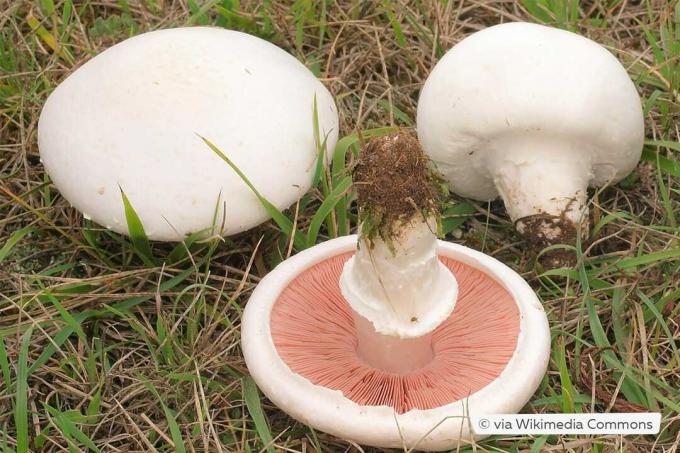
- Cap color: white, yellow-brown to reddish with age
- Hat shape: 4 to 12 cm in diameter, initially spherical, then flat, later spreading
- Stem: 3 to 8 cm, white, often brownish at base, white, single-layered, transitory ring
- Lamellae: crowded, not attached to the stem, initially pink, later brown to black
- Flesh: white, tender, thick, turning reddish when cut
- Taste: spicy
- Odour: faint pleasant
- Season: May to November
- Occurrence: fertilized meadows, fields, pastures, parks, gardens
- risk of confusion: poisonous carbolic mushroom (Agaricus xanthodermus), death cap (Amanita virosa)
A notice: If the lamellae of the meadow mushroom turn dark, you should leave it standing. Older specimens lose their taste to the point of being inedible.
frequently asked Questions
The shape and color of the hat, the nature and appearance of the tubes and lamellae, as well as the spores and the spore powder formed are to be used in the determination. The condition of the stem is also an important feature, as is the location.
You should not only know the collected mushrooms in your basket, but also know how many of them you are actually allowed to collect. The permitted amount is usually not precisely defined, but you should limit yourself to collecting it for your own use. About 1000 to 1500 grams of mushrooms are considered harmless in most cases. Anyone caught with significantly more mushrooms may risk fines of up to 10,000 euros.
In any case, a doctor must be consulted at the first sign of poisoning. One should try to empty the stomach. You can simply drink salt water (one tablespoon of table salt in a glass of water) to vomit. Furthermore, remains of the mushroom meal, cleaning residues or vomit must be secured.
